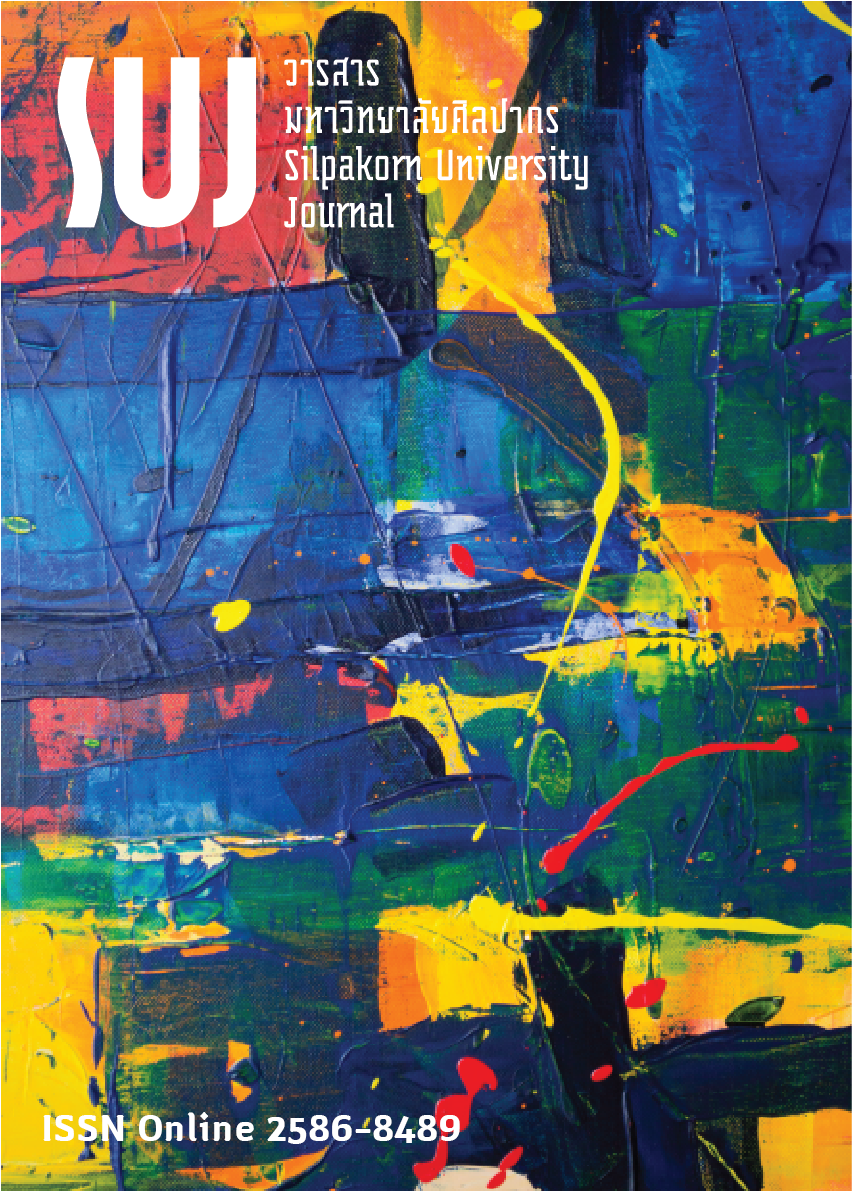ระดับการใช้ประโยชน์ตามขีดความสามารถรองรับได้ด้านจิตวิทยา เพื่อเพิ่มมาตรฐานการจัดการแหล่งท่องเที่ยวโดยชุมชน (Level of utilization upon psychological carrying capacity for enhancing community-based tourism management standard)
Main Article Content
Abstract
งานวิจัยชิ้นนี้ มีวัตถุประสงค์เพื่อกำหนดตัวชี้วัดและเกณฑ์มาตรฐานด้านจิตวิทยาสำหรับศึกษาขีดความสามารถรองรับได้และเพื่อประเมินขีดความสามารถรองรับได้ด้านจิตวิทยาในแหล่งท่องเที่ยวที่บริหารจัดการโดยชุมชน ครอบคลุมพื้นที่ศึกษา 2 แห่ง คือ ชุมชนเกาะพิทักษ์ จังหวัดชุมพร และชุมชนเกาะยาวน้อย จังหวัดพังงา ประชากร คือ นักท่องเที่ยว เก็บรวบรวมข้อมูลโดยใช้แบบสอบถาม จำนวน 400 ชุด และ 350 ชุด กำหนดเกณฑ์การตัดสินใจขีดความสามารถในการรองรับได้ 3 ระดับ คือ ระดับการใช้ประโยชน์จริงต่ำกว่าขีดความสามารถในการรองรับได้ ระดับเหมาะสมกับขีดความสามารถในการรองรับได้ และเกินความเหมาะสมของขีดความสามารถในการรองรับได้ ทำการคัดเลือกตัวชี้วัดและกำหนดเกณฑ์มาตรฐาน 3 ตัว คือ 1. การรับรู้ความแออัด 2. การพบปะผู้คนหรือความหนาแน่น และ 3. ความพึงพอใจ วิเคราะห์ผลแบบบรรยายเชิงพรรณนาโดยกำหนดขีดความสามารถในการรองรับการท่องเที่ยวเป็นค่าพิสัยหรือช่วงชั้น พบว่ากลุ่มตัวอย่างมีการรับรู้ความแออัด และการพบปะผู้คนอยู่ในระดับน้อย (ชุมชนเกาะพิทักษ์ (median = 1 และ 2 ตามลำดับ) และชุมชนเกาะยาวน้อย (median = 2 เท่ากัน)) มีความพึงพอใจโดยรวมในระดับมาก (ชุมชนเกาะพิทักษ์ (X̅ = 3.94) และชุมชนเกาะยาวน้อย (X̅ = 4.03) จัดว่าระดับการใช้ประโยชน์จริงมีค่าต่ำกว่าขีดความสามารถในการรองรับทั้งสองพื้นที่ โดยระดับการใช้ประโยชน์ที่เหมาะสมของจำนวนนักท่องเที่ยวต่อการรองรับได้ของชุมชนเกาะพิทักษ์กระจายอยู่ระหว่าง 250 - 350 คน และชุมชนเกาะยาวน้อยกระจายอยู่ระหว่าง 452 - 722 คน
This research aims to determine indicators and standard criteria for psychological carrying capacity and to evaluate carrying capacity of community-based tourism. The study sites are located in Koh Phithak in Chumphon Province and in Koh Yoa Noi in Phang-nga Province. The participants of this project are the tourists who visited these two places. The research method is the questionnaire survey, using 400 and 350 questionnaires for data collection. The criteria of carrying capacity are classified into 3 levels as follows: 1. Level of utilization which is below carrying capacity 2. Level of utilization which is suitable to carrying capacity and 3. Level of utilization which exceeds carrying capacity. By means of descriptive analysis, the data were examined, and three indicators and standard criteria were selected: 1. crowding 2. encounter or density and 3. total satisfaction which carrying capacity was determined as range or level. The results show that the participants have less awareness of overcrowding and human contact at Koh Phithak (median = 2 and 1. and Koh Yoa Noi (median = 2)). In terms of tourists’ satisfaction, participants are highly satisfied with Koh Phithak (X̅ = 3.94) and Koh Yoa Noi (X̅ = 4.03). The level of actual utilization of these two places is below carrying capacity. As a result, level of utilization for tourism show that the highest tourist carrying capacity at Koh Phithak are between 250 - 350, and 452 - 722 at Koh Yoa Noi.
Downloads
Article Details

This work is licensed under a Creative Commons Attribution-NonCommercial-NoDerivatives 4.0 International License.
References
Camp, E., & Fraser, D. (2012). Influence of Conservation Education Dive Briefings as a Management Tool on The Timing and Nature of Recreational SCUBA Diving Impacts on Coral Reefs. Ocean & Coastal Management, 12(61): 30-37.
Emphandhu, Dachanee. (2003). Teaching Programs The Management Plan for Eco-tourism (เอกสารประกอบการสอนการวางแผนจัดการการท่องเที่ยวเชิงนิเวศ). Bangkok: Kasetsart University.
Ferreira, S. L. A., & Harmse, A. C. (1999). The Social Carrying Capacity of Kruger National Park, South Africa: Policy and practice. Tourism Geographies, 1(3): 325-342.
Hallo, J. C., & Manning, R. E. (2010). Analysis of the Social Carrying Capacity of a National Park Scenic Road. International Journal of Sustainable Transportation, 2(4): 75-94.
Jurado, E. N., Tejada, M., García, F. A., & González, J. C. (2012). Carrying Capacity Assessment for Tourist destinations. Methodology for The Creation of Synthetic Indicators Applied in A Coastal Area. Tourism Management, 33(6): 1337-1346.
Lim, L. C. (1998). Carrying Capacity Assessment of Pulau Payar Marine Park, Malaysia. FAO Bay of Bengal Programme for Integrated Coastal Fisheries Management United Nations Development Programme. [Online]. Retrieved January 23, 2020 from http://www.fao.org/3/X5626E/x5626e09.htm#5.4%20criteria%20that%20affect%20capacity
Manning, R. E., Wang, B., Valliere, W., Lawson, S., & Newman, P. (2002). Research to Estimate and Manage Carrying Capacity of a Tourist Attraction: A Study of Alcatraz Island. Journal of Sustainable Tourism, 10(5): 388-404.
Mansfeld, Y., & Jonas, A. (2006). Evaluating the Socio-cultural Carrying Capacity of Rural Tourism Communities “Value Stretch” Approach. The Royal Dutch Geographical Society KNAG, 9(5): 583-601.
Na Thongkaew, Benjamas, & Ruksapol, Amnat. (2014). Carrying Capacity for Community - Based Tourism at Koh Phithak, Chumphon Province, Thailand: Phase I. KKU International Journal at Humanities and Social Sciences, 4(3): 49-71.
Phumsathan, Sangsan, Nisaiharn, Jiranan, & Songsaeng, Neramit. (2019). Physical Carrying Capacity and Recreation Use Level at Than Bokkhornrani National Park, Krabi Province (ขีดความสามารถในการรองรับด้านกายภาพและระดับการใช้ประโยชน์ด้านนันทนาการในพื้นที่อุทยานแห่งชาติธารโบกขรณี จังหวัดกระบี่). Journal of Environmental Management, 159(2): 4-25.
Shelby, B., & Heberlein, T. A. (1986). Carrying Capacity in recreation Settings. Corvallis: Oregon State University Press.
Suksawang, Songtham, Aimphan, Dachanee, & Tantisirin, Chatchai. (2008). Monitoring of Recreation Carrying Capacity at National Park (การติดตามขีดความสามารถในการรองรับได้ด้านนันทนาการของอุทยานแห่งชาติ). Bangkok: National Park, Wildlife and Plant Conservation.
Tourism Authority of Thailand. (2018). Thailand Tourism Awards (รางวัลอุตสาหกรรมการท่องเที่ยวไทย). [Online]. Retrieved February 1, 2019 from http://tourismawardsold.tourismthailand.org/th/
Trumbic, I. (2011). Tourism Carrying Capacity Assessment in the Mediterranean 1980-2009. Planning for Tourism, Leisure and Sustainability, 11(26): 175-180.
World Tourism Organization. (1984). Tourism Carrying Capacity. n.p.
Wolters, T. M. (1991). Tourism Carrying Capacity. Paris: The WTO and United Nations Environment Programme.


